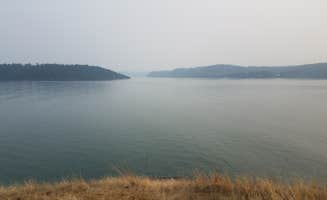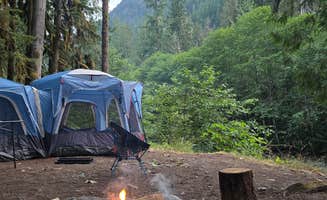Dispersed camping near Clinton, Washington offers primitive options across Whidbey Island and mainland forest service lands. Most sites are located in Mount Baker-Snoqualmie National Forest, with elevations ranging from 500 to 3,000 feet. Winter snowfall often restricts access to higher elevation sites from November through April, while summer conditions typically remain dry with daytime temperatures averaging 75-85°F.
What to do
Kayak to island campsites: Hope Island Marine State Park provides a unique primitive camping experience accessible only by boat. "This campground is on a tiny island in the Puget Sound. Rent kayaks (or bring your own) at Boston Harbor in Olympia. It's a short trip to the island, which is only accessible by boat," notes Raphaela H. The island features a walking trail around its perimeter with views of local marine life.
Berry picking expeditions: The Skykomish area along Highway 2 offers seasonal foraging opportunities alongside camping. "Fantastic berry picking & great views (when there is no smoke)," reports Josiah P. from US Highway 2 - Skykomish Area. Wild blackberries and huckleberries typically ripen between late July and September.
Off-road vehicle trails: Walker Valley ORV Recreation Area provides designated routes for off-road enthusiasts seeking camping with direct trail access. The area includes 36 miles of multi-use trails across 9,000 acres, with difficulty ratings from beginner to advanced. Riders need a Discover Pass for vehicle access.
What campers like
Riverside relaxation: Campsites along waterways offer natural sound buffers from road noise. At South Fork Sauk River, sites are "spread out along the South Sauk, and range from small pull-in spots to gorgeous, spreading sites. All had fire rings, and quite a few had spare firewood from previous occupants," according to Melisande M.
Privacy between sites: Many dispersed areas provide natural separation between campers. At Suiattle Riverside Camp, Kristen Z. found "This spot was so beautiful over looking a stream rushing over rocks. Ferns and big pines in the background." Natural vegetation creates privacy barriers between most sites.
Small island seclusion: Boat-in camping creates opportunities for complete solitude. "We ended up being the only people on the island," reports Raphaela H. about Hope Island Marine State Park. The island typically has just 2-4 designated camping spots, limiting overall visitor numbers.
What you should know
Road quality varies significantly: Access to many sites requires navigating increasingly rough terrain. "Various Large Pullout spots along this road. Nothing fancy and not secluded but got the job done," notes Bobby J. about FR 24's dispersed sites. Forest roads typically deteriorate after winter with repairs occurring gradually through summer.
Summer dust conditions: Dry conditions create visibility and comfort challenges. "The Mountain Loop Highway is gravel and dirt through here, and many people travel too fast on it and kick up a lot of dust. This gets everywhere, so be careful of allergies and expect to clean all your gear if you're camping in the summer," cautions Melisande M.
Wildlife interactions: Island camping includes wildlife management responsibilities. Jess G. reports, "There were raccoons on the island with us but other than that we had the place to ourselves." Proper food storage in sealed containers is essential for preventing unwanted animal encounters.
Tips for camping with families
Check water conditions: Boat-access camping requires weather monitoring for safety. "We kayaked to the island, the waters were pretty rough so I would recommend for anyone planning to stay here to look into the waters, tide and wind report the day of," advises Jess G. from Hope Island Marine State Park.
Choose campgrounds with trails: Sites with built-in hiking opportunities provide activities without additional driving. "There's a trail that seems to go back but just a dead end," mentions Brendan about NF-27 Tunnel Creek. Most forest service roads connect to trail networks within walking distance of campsites.
Insect preparation: Summer months bring increased mosquito activity. "Lots of mosquitoes around," notes Brendan. Bringing repellent, head nets, and lightweight long-sleeved clothing helps manage discomfort, particularly during dawn and dusk hours.
Tips from RVers
Fire ring availability: Most dispersed sites include established fire rings despite primitive conditions. At FR27 Landing, Sarah S. notes the site has "About 4 fire rings set up and the road is pretty easy getting here." Seasonal fire restrictions typically apply from July through September depending on conditions.
Site capacity considerations: Some dispersed areas accommodate multiple vehicles despite remote locations. "Great large flat spot for camping. Could easily fit about 5 cars here," reports Sarah S. Larger groups should coordinate arrival times, as claiming these areas operates on first-come basis with no reservation system.



